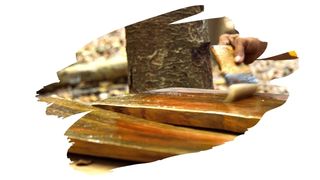Wood hardeners help prevent rotting wood from falling apart. However, a hardener-treated section of wood can stand out in stark contrast to the natural timber surrounding it.
And that contrast can look even worse if you apply a penetrating oil-based wood stain over it.
So, in this post, you’ll discover what really goes into wood hardeners. You’ll also learn exactly why these durable resins aren’t that great at absorbing penetrating stains.
And we reveal an alternative staining product that can add grain popping color over any wood hardener.

This post may contain affiliate links to products that we receive a commission for (at no additional cost to you). Learn more here.
Can Wood Hardeners Absorb Stain? What Are Hardeners Made Of?
Well, wood hardeners are made from thermoplastic acrylic resins.
These resins are key to preventing rotting wooden beams from completely falling apart (if you catch wood rot early enough). That’s because this substance forms an incredibly tough material that is much harder (and water resistant) than even the very wood it’s been applied to.
Now, this is great news when it comes to maintaining the integrity of timber marred by rot. However, it’s not so great when it comes to penetrating finishes.
You see, wood hardeners do not have pores or fibers like natural solid wood. And, without any porous space to soak into, an oil-based stain will simply run right off wood hardener.
Is Wood Hardener A Type Of Epoxy?
While both wood hardeners and epoxy resins cure into hard substances, their base ingredients are very different.
Wood hardeners contain acrylic resins, which is made from acrylic acid and acrylate monomers. While epoxy contains epoxy resins, which are made from polyepoxides.
Does Wood Hardener Actually Work On Wood?
Wood hardener is a quick and easy way to maintain the integrity of rotting wood beams — whether they be in your bathroom or even around your kitchen sink.
Related Post: What To Do About Rotting Wood In Your Bathroom
However, wood hardeners work by reinforcing the rot-free sections of a beam. But, wood hardeners do not restore already rotted and decayed sections of wood. You would need to use a wood filler product, (such as Epoxy wood fillers), to pack out otherwise crumbling sections of rotted wood.
That is why a hardener product should be used as soon as possible to prevent the spread of wood rot.
So, Should You Use Wood Hardener Before Staining? Can You Apply Oil Stain Over It?
Wood stains color natural timber by sinking down into it, and soaking wood fibers. But, a hardener simply isn’t capable of absorbing wood stain.
So, if you apply oil-based stain over a hardener-saturated wooden beam, you’ll end up with blotchy looking stain.
Now, as to whether you should use wood hardener before staining? Honestly, yes, you always should.
Stains are about style over substance. But, a wood hardener is all about making sure that kitchen countertop or bathroom beam, doesn’t completely collapse on you. And that simply has to take priority.
Related Post: Rotting Wood Around Your Sink? 3 Ways To Protect That Wooden Worktop
So, What Can You Do Instead Of Using Oil Stain?
If you want to add color over wood hardener, you need a stain that doesn’t need to sink into lumber.
In other words, you need a stain product that ‘sits’ on the surface of timber. In which case, you should use a gel stain instead of an oil-based wood stain.
Can You Really Apply Gel Stain Over Wood Hardener?
Well, gel stains add color to wood the way a coat of paint does. It sits on the surface of wood and forms a film on top of it.
However, while paints are made up of a solid block of color, gel stains are heavily tinted. Meaning they’re still semi-transparent, just enough to allow natural wood texture to show through.
So, unlike penetrating stains, gel stain can change the color of timber without needing to sink into wood.
And one of the best gel stain products on the market is Varathane Premium Gel Stain. This fast-drying gel stain is available in 9 natural-looking colors.
It’s thick non-drip formula means that it won’t leave behind streaks on upright wooden surfaces. And it only needs a couple of coats in order to give any timber surface incredible tone.
You can check out the latest price for this gel stain over on Amazon.com
Now, no matter what gel stain product you decide to use, always wait for wood hardener to dry first. Applying gel stain onto still drying/curing wood hardener will mean you’ll end up with a boat load of adhesion problems.
How Long Does It Take Wood Hardener To Dry? Depending on the brand, a single coat of wood hardener can take anywhere from 2 to 6 hours to dry.
To Sum Up, Here Are The 3 Key Takeaways From This Post…
- 1). Wood hardeners are made from acrylic resins. These resins are non-porous, waterproof, and do not absorb penetrating wood stains.
- 2). If you apply penetrating wood stain over wood hardener saturated wood, you’ll end up with blotchy looking stain color.
- 3). So instead, use gel stain over wood hardener. These non-penetrating stains can add a semi-transparent coat of color to wood.
References:
Okadaa, Katsuhiko, Kouichi Yamaguchi, and Hirofumi Takeda. “Acrylic/polyester hybrid powder coating system having excellent weather durability.” Progress in organic coatings 34.1-4 (1998): 169-174.
Hsissou, Rachid. “Review on epoxy polymers and its composites as a potential anticorrosive coatings for carbon steel in 3.5% NaCl solution: Computational approaches.” Journal of Molecular Liquids 336 (2021): 116307.

![Will Tacky Wood Stain Eventually Dry? [What To Do When Stain Is Not Drying] will tacky stain eventually dry](https://www.thewoodworkplace.com/wp-content/uploads/2022/10/Banner-502-150x150.jpg)

